M
I
C
R
O
S
T
O
R
Y
O
F
A
R
T
........................................................

NOW COMPLETED:

........................................................
MICROSTORY OF ART
ONLINE JOURNAL FOR ART, CONNOISSEURSHIP
AND CULTURAL JOURNALISM
........................................................
INDEX | PINBOARD | MICROSTORIES |
FEATURES | SPECIAL EDITIONS |
HISTORY AND THEORY OF ATTRIBUTION |
ETHNOGRAPHY OF CONNOISSEURSHIP |
SEARCH

........................................................



 >MICROSTORIES
>MICROSTORIES
- Richard Serra
- Martin Scorsese
- Claude Simon
- Sunshine
- Werner Herzog
- The Creation
- Marcel Duchamp
- Nino Rota
- Wölfflin and Woolf
- Hansjörg Schneider
- Kraftort Arkadien
- Visual Biography
- Schlaraffenleben
- Die Geisteswissenschaften
- The Voyeur
- Buzzword Sustainability
- Paul Verlaine
- Tao Yuanming
- New Beginning
- Seneca
- Still Lifes
- Charles Baudelaire
- Frédéric Chopin
- The Art History of Sustainability
- Wang Wei
- Solarpunk
- Historians of Light
- Lepanto
- Renaturalization
- Plates
- Snow in Provence
- Learning to See
- Picasso Dictionaries
- Peach Blossom Spring
- Picasso Tourism
- Tipping Points
- Sviatoslav Richter
- Weather Reports
- Treasure Hunt
- Another Snowscape in Picasso
- Picasso in 2023
- Dragon Veins
- The Gloomy Day
- The Art of the Pentimento
- Reforestation
- The Status of Painting
- Emergency Supply
- Punctuality
- Watching Traffic
- Zhong Kui
- How Painting Survived the 1990s
- Confirmation Bias
- Sustainability and Luxury
- Garage Bands
- Picasso and Artificial Intelligence
- Eyes of Tomorrow
- Picasso in 2023 2
- Gluing Oneself to Something
- Suburbia
- Bamboo
- Sustainability and Carpe Diem 1
- Interviews with Bruegel
- Sustainability and Carpe Diem 2
- Coffee & Sugar
- Bamboo 2
- Picasso in 2023 3
- Sustainability and Carpe Diem 3
- Cherry Orchard
- Old Magazines
- Chance
- Nick Drake
- Harlequin
- The Smartphone & the Art Book
- Atlas Syndrome
- The Kitchen
- Atlas Syndrome 2
- Consideration
- Tori Amos
- School
- Orchard Auctioning Day
- The Hundred Years’ War
- Sócrates
- Chameleon
- Nefertiti Bust
- Picasso as a Computer
- Sunflowers
- Philemon & Baucis
- Ode to the Radio
- Childhood
- Wimmelbild
- Restitution
- Nick Drake 2
- Wishful Thinking
- Sundays
- The Independent Scholar
- September
- The Fisherman by Pirosmani
- Microadventure
- Sociology
- Salvator Mundi
- Chillon
- Appassionata
- Amber
- Homer
- Berlin
- Planet Walk
- Improvisation
- Seeing Picasso
- These Nice Kids
- Robber
- The One
- The Sea Turtle
- Zoo
- Through the Hush
- Wunderkammer
- I Do Not Seek, I Find
- Shopping Mall
- Food Hamper
- The Secretary
- This Gate
- Nor Rainy Day
- House on a Hill
- Beautiful Island
- Second-hand Bookstore
- Flat
- Slap in the Face
- Serra, Wenkenpark
- Apologies
- The Bells
- Nordmann Fir
- Picasso Wanting To Be Poor
- Picasso, Pirosmani
- A Brief History of Sculpture
- 24 Sunsets
- Rusty Phoenix
- Glove
- Wintry Stanza
- A Song
- Like A Beatle
- Catching An Orange
- Solar Bees
- Permaculture

 >FEATURES
>FEATURES
- Van Gogh On Connoisseurship
- Two Museum’s Men
- Ende Pintrix and the City in Flames
- Titian, Leonardo and the Blue Hour
- The Man with the Golden Helmet: a documentation
- Un Jury d’admission à l’expertise
- Learning to See in Hitler’s Munich
- Leonardo da Vinci and Switzerland
- The Blue Hour Continued
- The Blue Hour in Louis Malle
- Kafka in the Blue Hour
- Blue Matisse
- Blue Hours of Hamburg and LA
- A Brief History of the Cranberry
- The Other Liberale in the House
- The Blue Hour in Raphael
- Who Did Invent the Blue Hour?
- Monet on Sustainability
- Velázquez and Sustainability
- The Blue Hour in Guillaume Apollinaire
- Van Gogh on Sustainability
- The Blue Hour in Marcel Proust
- Picasso and Sustainability
- The Contemporary Blue Hour
- The Blue Hour in 1492
- The Blue Hour in Hopper and Rothko
- Hopper and Sustainability
- The Blue Hour in Ecotopia
- The Hour Blue in Joan Mitchell
- Explaining the Twilight
- The Twilight of Thaw
- The Blue Hour in Pierre Bonnard
- Explaining the Twilight 2
- Picasso on Stalin
- Rubens on Sustainability
- The Salvator Mundi in Bruegel and Rubens
- The Blue Hour in Leonardo da Vinci and Poussin
- The Blue Hour in Rimbaud
- Faking the Dawn
- Frost and Thaw in Ilya Ehrenburg
- Picasso, Stalin, Beria
- Picasso, Solzhenitsyn and the Gulag
- Shostakovich on Picasso
- Hélène Parmelin in 1956
- Historians of Picasso Blue
- Picasso Travelling to Moscow 1
- The Blue Hour in Caravaggio
- Picasso Travelling to Moscow 2
- Picasso, the Knife Game and the Unsettling in Art
- Some Notes on Leonardo da Vinci and Slavery
- Picasso Moving to the Swiss Goldcoast
- The Blue Hour in Camus
- The Blue Hour in Symbolism and Surrealism
- Caspar David Friedrich in His Element
- Exhibiting the Northern Light
- Caspar David Friedrich in His Element 2
- Robert Schumann and the History of the Nocturne
- The Blue Hour in Robert Schumann
- Caspar David Friedrich and Sustainability
- The Twilight of Thaw 2
- Multicultural Twilight
- The Blue Hour in Anton Chekhov
- The Blue Hour in Medieval Art
- Twilight Photography
- The Blue Hour in Bob Dylan
- Iconography of Optimism

 >SPECIAL EDITIONS
>SPECIAL EDITIONS
- Visions of Cosmopolis
- Mona Lisa Landscapes
- Turner and Ruskin at Rheinfelden
- Painters On TV & On TV
- Spazzacamini in Art
- A Last Glance at Le Jardin de Daubigny
- The Experimental Cicerone
- A Dictionary of Imaginary Art Historical Works
- Iconography of Blogging
- Begegnung auf dem Münsterplatz
- Cecom
- Das Projekt Visual Apprenticeship
- Those Who See More
- A Fox on Seeing with the Heart
- Sammlung Werner Weisbach
- Daubigny Revisited
- Some Salvator Mundi Microstories
- Some Salvator Mundi Afterthougths
- Some Salvator Mundi Variations
- Some Salvator Mundi Revisions
- A Salvator Mundi Questionnaire
- A Salvator Mundi Puzzle
- Unknown Melzi
- Francis I and the Crown of Charlemagne
- From Amboise to Fontainebleau
- Drones Above Chambord
- Looking Back At Conques
- Flaubert At Fontainebleau
- Images of Imperial Ideology
- The Chronicles of Santa Maria delle Grazie
- Seeing Right Through Someone
- Melzi the Secretary
- Eying Glass
- A Foil to the Mona Lisa
- A Renaissance of the Cartoon
- Sketching a Family Tree
- Venetian Variations
- A Brief History of Digital Restoring
- A Consortium of Painters
- Leonardeschi and Landscape
- A Christ in Profile
- Learning to See in Spanish Milan
- A History of Gestures
- Leonardo and Josquin
- A Renaissance of the Hybrid
- Suida and Heydenreich
- The Watershed
- Three Veils
- From Beginning to End
- Connoisseurship of AI
- Twilight and Enlightenment
- The Blue Hour in Chinese Painting
- Dusk and Dawn at La Californie
- Iconography of Sustainability
- The Blue Hour in Goethe and Stendhal
- The Sky in Verlaine
- The Blue Hour in Paul Klee
- Iconography of Sustainability 2
- The Blue Hour in Charles Baudelaire
- From Bruegel to Solarpunk
- Some Salvator Mundi Documentaries
- Some More Salvator Mundi Monkey Business
- The Windsor Sleeve
- Brigitte Bardot’s Encounter with Picasso
- Art Historians and Historians
- A Salvator Mundi Chronicle
- The Salvator Mundi and the French Revolution
- The Fontainebleau Group
- The Encounter of Harry Truman with Pablo Picasso
- The Fontainebleau Group Continued
- The Windsor Sleeve Continued
- The Salvator Mundi in Early Netherlandish Painting 1
- Some Salvator Mundi Resources
- A New Salvator Mundi Questionnaire
- The Woman in Picasso
- The Yarborough Group
- Melzi, Figino and the Mona Lisa
- The Yarborough Group Continued
- A Salvator Mundi Global History
- The Salvator Mundi in Medieval Art
- The Salvator Mundi in Medieval Art 2
- The Salvator Mundi in Early Netherlandish Painting 2


 >HISTORY AND THEORY OF ATTRIBUTION
>HISTORY AND THEORY OF ATTRIBUTION
- The Mysterious »Donna Laura Minghetti-Leonardo«
- Assorted Demons of Connoisseurship
- Panofsky Meets Morelli
- Discovering the Eye of Sherlock Holmes
- Handling the Left-handed Hatchings Argument
- Visual History of Connoisseurship
- Alexander Perrig
- Connoisseurship in 2666
- What Postmodernity Has Done to Connoisseurship
- Dividing Four Fab Hands
- A Leonardesque Ambassador
- Test Cases in Connoisseurship
- A Raphael Expertise
- How to Tell Titian from Giorgione
- Louise Richter
- The Unique Property in the History of Connoisseurship
- An Expertise by Berenson
- The Book of Expertises
- An Album of Expertises
- An Expertise by Friedländer
- A Salvator Mundi Provenance
- How to Tell Leonardo from Luini
- An Expertise by Crowe and Cavalcaselle
- An Expertise by Bayersdorfer
- An Expertise by Hermann Voss
- An Expertise by Hofstede de Groot
- Leonardeschi Gold Rush
- An Unknown »Vermeer«
- An Expertise by Roberto Longhi
- An Expertise by Federico Zeri
- A Salvator Mundi Geography
- A Salvator Mundi Atlas
- The Bias of Superficiality
- 32 Ways of Looking at a Puzzle
- James Cahill versus Zhang Daqian
- Five Fallacies in Attribution
- On Why Art History Cannot Be Outsourced to Art Dealers
- On Why Artificial Intelligence Has No Place in Connoisseurship
- Salvator Mundi Scholarship in 2016
- Leonardo da Vinci at the Courts
- The Story of the Lost Axe
- The Last Bruegel
- A Titian Questionnaire
- On Where and Why the Salvator Mundi Authentication Did Fail
- The Problem of Deattribution

 >ETHNOGRAPHY OF CONNOISSEURSHIP
>ETHNOGRAPHY OF CONNOISSEURSHIP
MICROSTORY OF ART
ONLINE JOURNAL FOR ART, CONNOISSEURSHIP
AND CULTURAL JOURNALISM
........................................................

***
ARCHIVE AND FURTHER PROJECTS

1) PRINT


***
2) E-PRODUCTIONS


........................................................

........................................................

........................................................
FORTHCOMING:


***
3) VARIA

........................................................

........................................................

........................................................

........................................................

........................................................
***
THE GIOVANNI MORELLI MONOGRAPH

- The Giovanni Morelli Monograph
........................................................
MICROSTORY OF ART
ONLINE JOURNAL FOR ART, CONNOISSEURSHIP AND CULTURAL JOURNALISM
HOME
MICROSTORY OF ART ONLINE JOURNAL FOR ART, CONNOISSEURSHIP AND CULTURAL JOURNALISM A Salvator Mundi Atlas |
See also:
Some Salvator Mundi Microstories
Some Salvator Mundi Afterthoughts
Some Salvator Mundi Variations
How To Tell Leonardo From Luini
A SALVATOR MUNDI ATLAS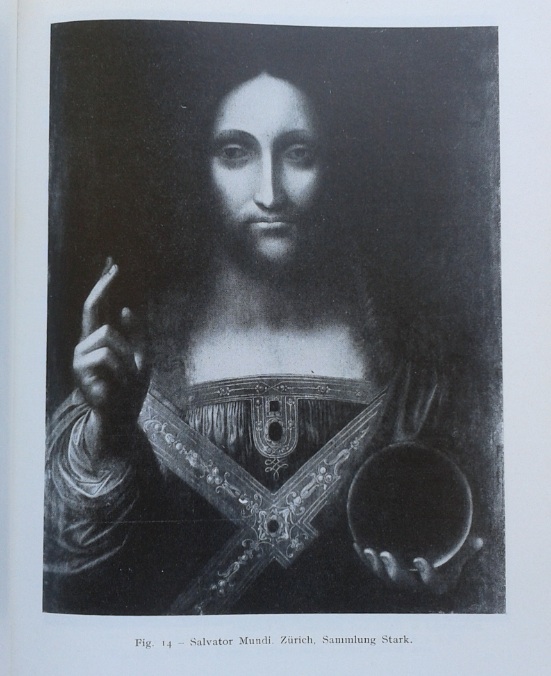
This is meant to put another Salvator Mundi version on the map: this time the all-too-little known Zurich version
(formerly collection of Viktor Stark). Again it is about the interplay of history, connoisseurial observations and
informations as to materiality.
But this time it is not about one particular hypothesis (although in some sense we’ll expand our hypothesis concerning
the Detroit Salvator (see my Salvator Mundi Geography), and also concerning Counter-Reformatory and Spanish-ruled
post-1585 Antwerp and its wood supply). This time it is about one certainty, and about spelling out lots of hypotheses
that can be linked to this one certainty. Which is: The Detroit and the Zurich Salvator Mundi versions are related.
And we have further new informations (exclusively published here for the very first time). And this informations come
from the archives of Leonardo-scholar Ludwig Heinrich Heydenreich at Munich. I owe access to these informations to Ben
Lewis whom I had advised to search for these archives (in Munich), and I am now combining these informations with my
findings on the Detroit Salvator. We’ll be travelling in time and space, and since I also have a project in preparation
which is called the Leonardeschi Database and Atlas, I am calling this A Salvator Mundi Atlas.
(Begun: 19 January 2020; completed: 21 January 2020)


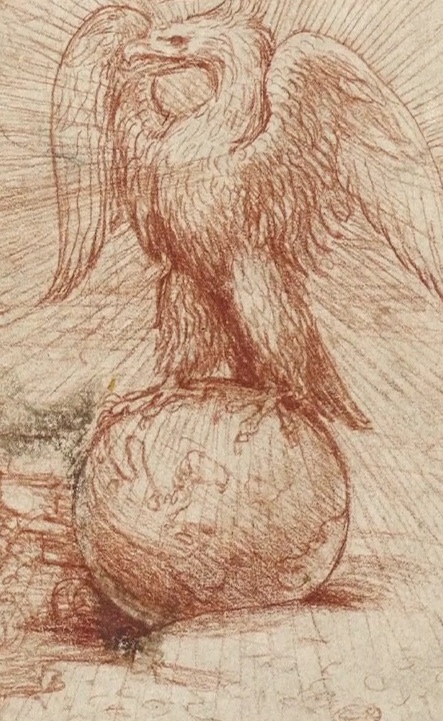
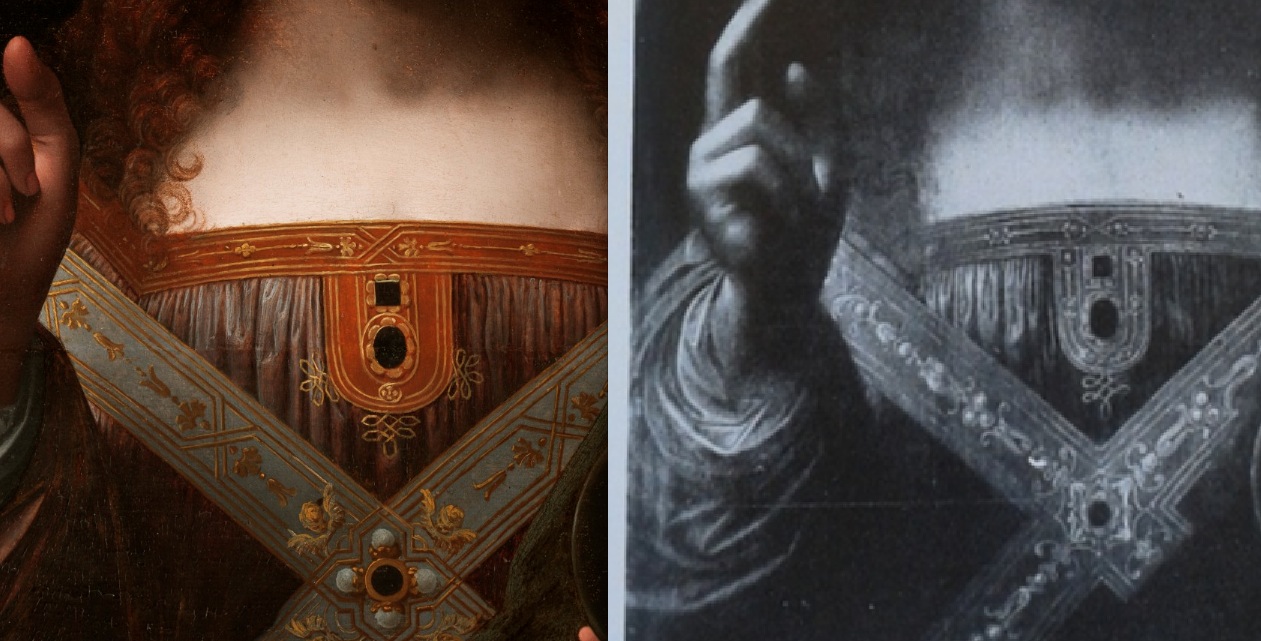
One) A Sort of Barcode
We might start with looking and comparing the shadow pattern in the throat area; or we might start with comparing the
ornament on the crossed bands of the stole. The ornaments are not identical, but of the same type, the shadow patterns
are very similar. But there is something else, and the certainty that Zurich and Detroit are related relies on this
›something else‹.
Below the neck of Christ we see a horizontal band, and below this band we see vertical folds. The nature of the garment
affects the cloth below the horizontal band to show what I am calling fork shapes; and I have always thought of these
fork shapes as a sort of barcode. Think of them as words, and these words made out of syllables, with a fold being a
single syllable. If we scrutinize the fork shapes in Detroit and in Zurich, especially on the left side of the garment
(seen from the point of view of the beholder), we realize that they are built of the almost identical ›words‹. Column-,
or tree-trunk-like cluster shapes that are seen in these two Salvator Mundi versions exclusively. And this is why I am
saying that it is a certainty that these two version are related. I am not speaking of identity, but the level of
similarity is comparable to a signature, once given in a certain way, and the next time a little differently, depending
on the mood etc. of the person giving his signature. But syllables and words stay the same.
Two) On Cedarwood
According to Zurich botanists the Zurich Salvator is painted on cedarwood. How do we know? Ludwig H. Heydenreich says
so in his first expertise concerning the Zurich picture (typoscript in the Heydenreich archives). This first expertise was
written after the Second World War and at a time Heydenreich did not know that many Salvator Mundi versions. Not that
many as he knew in 1964, when he published his Salvator Mundi paper in the Raccolta Vinciana. But at the time of his
first expertise he knew that the picture was going to be restored. He did some more research that led also to his 1964
paper, but also to his second expertise (draft being extant), in which he expressed his opinion that the picture was a
workshop cooperation, i.e. of the same category as the Bacchus in the Louvre and the second version of the Madonna
of the Rocks (these two examples named by Heydenreich). In other words: Heydenreich had ascribed the Zurich picture to
›Leonardo and workshop‹ (or, if you like, to ›Workshop and Leonardo‹). Without a question mark.
Apparently Heydenreich did not know what seems to be the consensus among panel scholars today: that cedarwood is
extremly unusual, except for one region: the south of Spain.
Apparently we know also of some 17th century panels that were used in Northern countries. And perhaps, but only perhaps
there are also exceptions as for Italy. But probably we can all agree that cedarwood is not a type of wood that Leonardo
did recommend. He transmitted a fable about a cedar. But most likely the mere fact alone that the Zurich picture is on
cedarwood makes it rather unlikely that it is coming from Leonardo’s workshop. And it is also rather unlikely that it is
coming from Italy.
But now we have to come back to Antwerp. And the date of 1585 seems to be an absolutely crucial date as for Salvator
Mundi studies. Why? Because after the fall of Antwerp in 1585 the import of Baltic oak via the Baltic Sea and via river
Scheldt was blocked. The question is, and this is a crucial question as for a whole cluster of Salvator Mundi pictures:
how was wood supply organized for post-1585 Antwerp, when many painters, not willing to emigrate to the North, stayed in
the city – to meet the demand for Counter-Reformation artworks? And how wood supply for the Spanish troups in the South
of the Netherlands? If Baltic oak was short supply, which type of wood still got into the city, after 1585? Was the
Zurich picture painted on wood that had been imported from Spain? Or is it a picture that had been made in Spain? And
how might it, then, be related to the Detroit picture which we had placed in Antwerp recently.
We will come back to these questions below, but first we will consider, on an abstract level, how these two pictures
might be related.

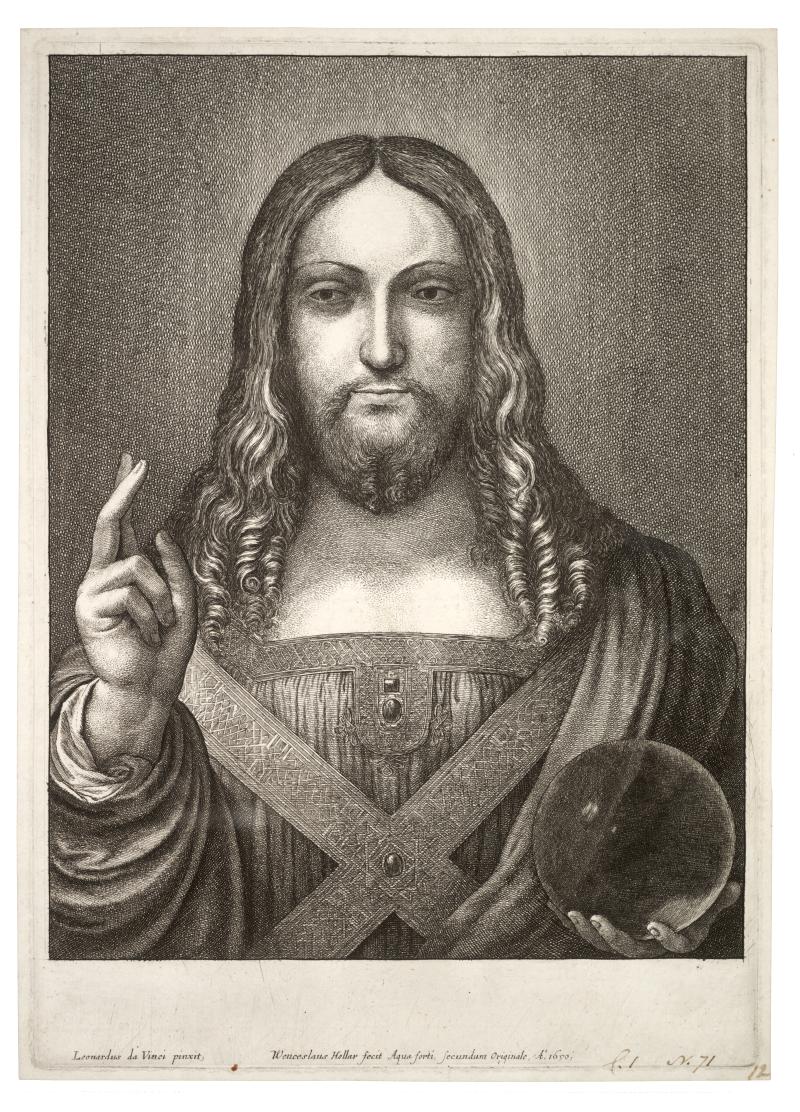
Three) Related How?
Unfortunately the Zurich picture has not been dendrochronologically dated. But the good thing is: there are only three
possibilities as to how the Zurich and the Detroit picture can be related, and, given that we all agree that the
pictures are related, it must be one of these three possibilities. Which are:
a) both depend – directly or indirecly – from one and the same source;
b) Zurich is derived – directly or indirectly – from Detroit; and
c) Detroit is derived – directly or indirectly – from Zurich.
I am neglecting a forth possibility (Detroit and Zurich being copies after two distinct, but related pictures), because
this possibility would lead again to the same question of how these two other distinct pictures might be related.
We might now play around endlessly with these three possibilities, always considering that cedarwood somehow should be
linked to Spain. We might be considering that we have to do here with two workshops, instead of only one (and
perhaps an Antwerp one). What, for example, if Zurich is a picture that had been made in Spain after a lost Leonardeschi
painting, and also a cartoon had been made – that somehow got to another workshop in Antwerp?
But this might be rather far-fetched, and I am preferring here to comment only briefly on our three possibilities and
their respective implications:
As to a): this seems possible and this possibility’s implications seem no cause no further problems;
as to b): this seems also possible; it would mean that the Master of the Zurich picture, deliberately or not, painted a
face that is elongated as for the upper part and seemingly also slightly in motion, to the effect that a quiet and
statuesque balance, characteristic for Hollar as for the Detroit picture, got lost;
as to c): this is the possibility that, althought it seems possible if taken for itself, causes complications in context.
Since we had postulated that Hollar and Detroit depend from the same lost source, it would now become difficult to
explain the relation between Hollar and Detroit, since the lost source cannot be Zurich. It is absurd to assume that
Hollar copied Zurich and corrected the elongated face, and that, independently, the author of the Detroit picture did
exactly the same thing, so that Hollar and Detroit, again and as a result, appear to be similar. For this reason, unless
someone comes up with a better theory, I tend to dismiss c) as being rather unlikely, even if you could say that someone
copied Zurich, corrected the posture of Christ, so that the Detroit master and Hollar could copy this corrected copy
after Zurich. I tend to use Ockham's razor here, which means that I am going to prefer a) and b) since these
possibilities offer reasonable hypotheses with less complicated additional assumptions.
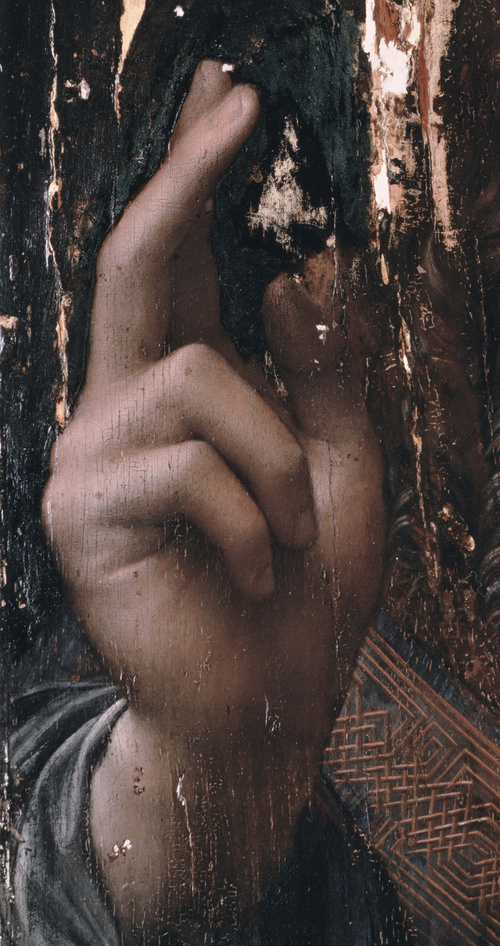
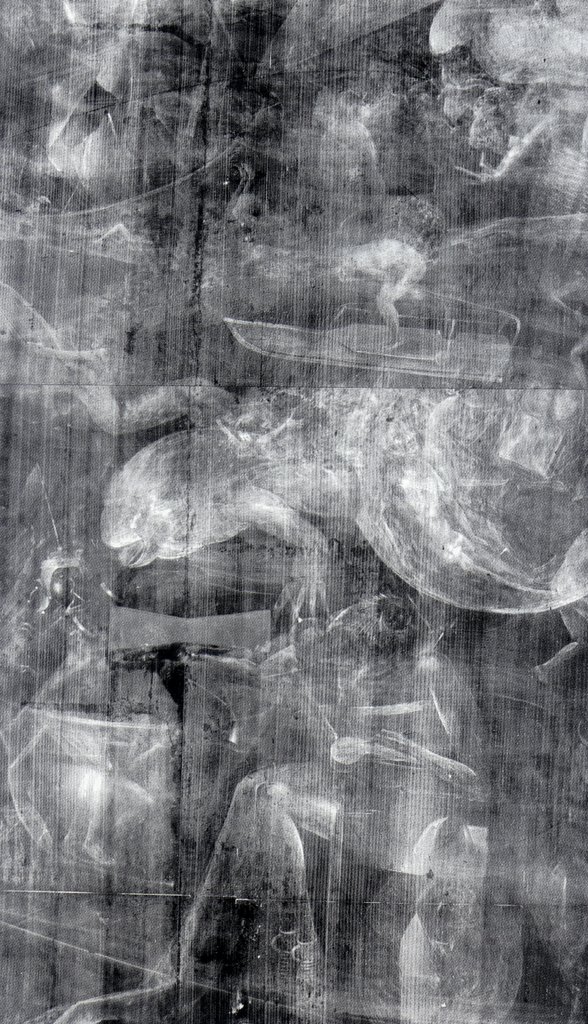
Four) Another Pentimento
The Zurich picture had not only been examined by Zurich botanists. Heydenreich, in his second expertise, mentions that
he had seen a photograph based on infraredreflectography, and that, in his opinion, the ornaments on the stole’s bands
had been changed. Although he thinks of later overpaintings or additions (as to the pearls), he uses, in this respect
the notion of pentimento, and he assumed that, in the original state, a geometrical pattern had shown instead of the
ornaments which are, as we may add here, of the same type as that in the Detroit picture.
We may say a word here on the notion of pentimento as well as on its use (and misuse), and we may begin with a
rhetorical question (pentimenti pictures above: salvatormundirevisited.com; hieronymus-bosch-miscellanea.blogspot.com):
Given that we find a pentimento in a picture – are we allowed to immediately claim that this pentimento ›cries‹:
original?
Certainly not, any first semenster art student will now immediately say. Because not any pentimento is the result of a
change of mind. Instead we should think of distinguishing, broadly speaking, two types of pentimenti: the first type,
being exemplified here by Hieronymus Bosch who had painted a gigantic salamander, only to overpaint it with something
else, indeed ›cries‹ original. Because it is the result of an artist’s change of mind. But the second type is the result
of workshop practices: something goes wrong and has to be corrected. If it is about the working with templates, even
various templates (for a blessing hand; for an ornament pattern), it can be that the position of a preconceived element
has to be shifted. And any informed reader will understand what I am getting at here: Any pentimento has to be interpreted,
and it is not unfair to say that art dealers, even scholarly dealers, tend – tend – to prefer the interpretation of
pentimenti as changes of mind that indicate that a picture in question might be an original.
As for the Abu Dhabi Salvator and its notoriously famous thumb pentimento, we must remind here that conflicting
interpretations do exist, even among proponents of an attribution to Leonardo. And it is true: the thumb pentimento is
ambiguous, it has to be interpreted. But what I am criticizing here, in passing by, is that around the year 2011 one had
presented a pentimento to the world without a transparent discussion giving at least the scientific community the exact
reasons why it should be interpreted in one way and not in another. What we have seen instead is the excess of
confirmation bias that I have criticized numerous times, and the marginalization of the restorer’s more nuanced (and more
ambiguous) view of that thumb pentimento, not to speak of the marginalization of even more critical views. But back to
the Zurich picture and its ›pentimento‹ (if there is indeed one, because I have not had a chance to see the IRR-picture).
If Heydenreich is right in that the ornaments in the Zurich picture are later and newly painted elements, and if there is
indeed a knotted-band pattern underneath, would we be inclined to go back and to ask again if Heydenreich still may be
right, in that the picture is rather close to a Leonardesque source or even to Leonardo? Maybe. But first we would be
inclined to ask if not the hypothetical lost picture from which, in our view, Hollar and Detroit depend, indeed may have
shown a geometrical pattern (since such does show in Hollar), and if Zurich is not rather a further version, made in
Antwerp, that also, as Detroit does, shows a Flemish style ornament, for the simple reason that the Antwerp master who
did it, did chose to do so?
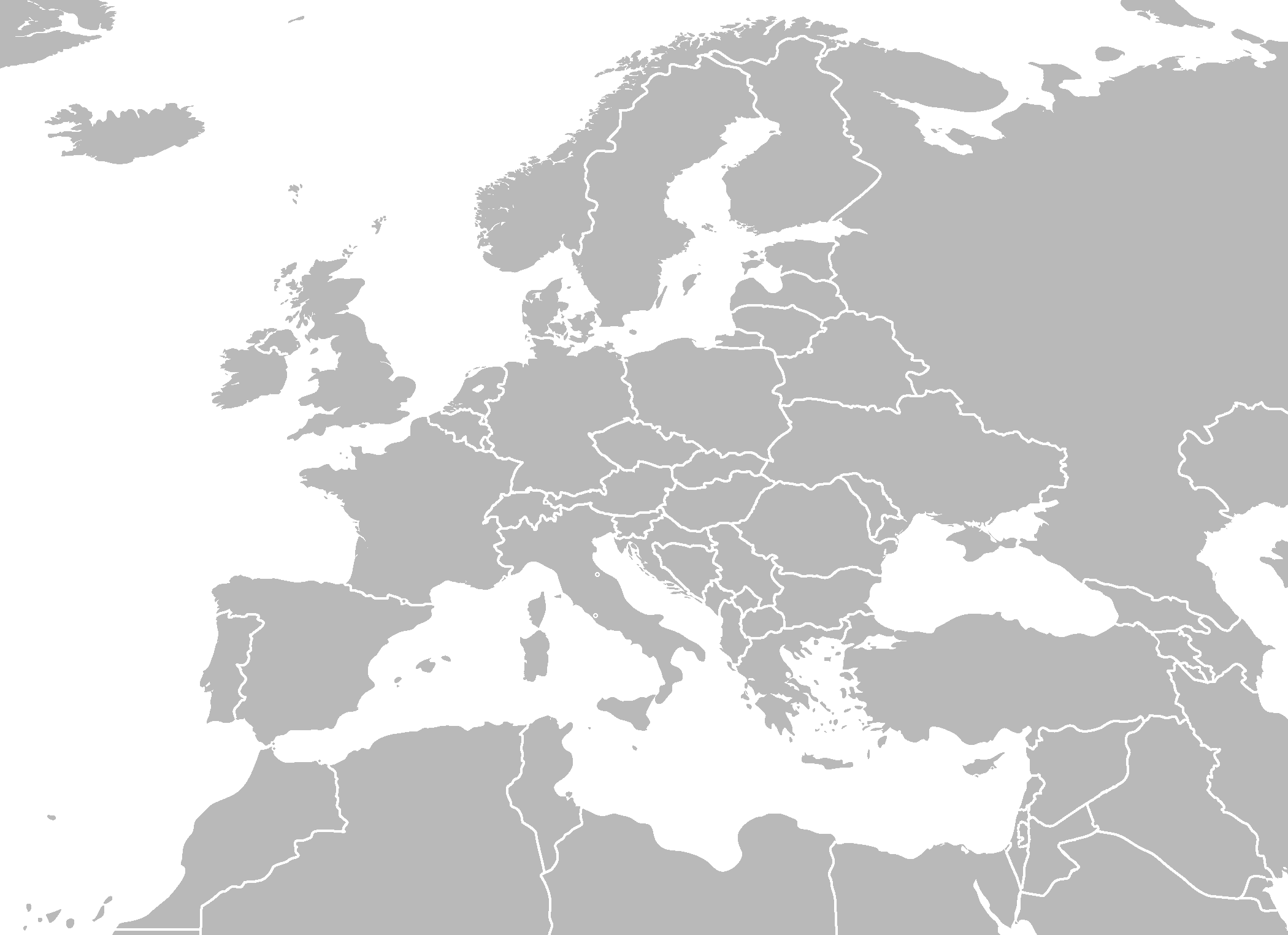
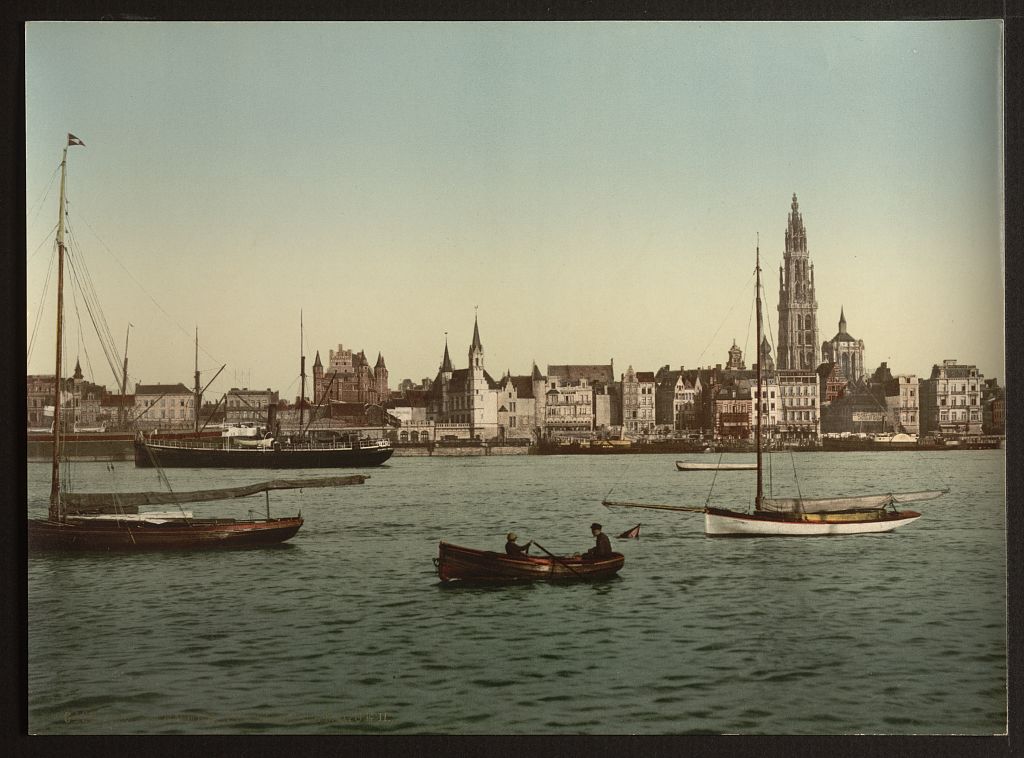
Five) Taking a Broader View: the Northern Cluster of Salvator Mundi Pictures or:
Six Pictures Embedded in One Consistent Theory
If you have read this far, dear reader, I am inviting you now to take a broader view. Let’s take a step back and let’s
look at a map of Europe, and then let’s think about what we’ve got.
Look, there is Antwerp, situated at the river Scheldt. In 1585 it got conquered by Spanish troups (actually Spanish and
German troups), and this did change a lot. Above I had briefly mentioned that the river Scheldt got blocked
(or ›closed‹) by the Northern States, fighting the Spanish troups. But modern economic and social historians do tell
us that the blocking of the river Scheldt is actually a kind of myth. The Scheldt never got closed, because the
Northern states were keen to impose custom fees and taxes on trade. But what happened still had a dramatic effect. And
what happened was that all the merchants with an affinity to the Protestant faith did leave the city, went to Hamburg
or other places. And those who stayed were rather from the southern part of Europe, from Italy, and also and most
importantly: from Spain.
The Baltic oak trade had been Hanseatic trade. This must have diminished or disappeared, and raw materials like wood,
after 1585, were brought in from Spain or generally southern Europe. And this structural change does not only offer a
perfectly reasonable explanation why we may find a Salvator Mundi painted on cedarwood in Antwerp (which is related to
another Antwerp painting), it does offer a historical explanation for the few Northern paintings of cedarwood in
general.
And: it does, perhaps, even offer an explanation for the similarities between the Antwerp paintings on the one
hand, and the two associated with France (Warsaw and ex-Versailles). Because Warsaw is on French oak, and even this type
of wood might have been used in Antwerp, at a time Baltic oak was no longer available (ex-Versailles, by the way, is
painted on canvas).
What do we got now? We actually have, after we had proposed that Detroit may be from Antwerp, a theory in
which no less than six Salvator Mundi versions are embedded. Prove me wrong, but I tend to think that Detroit and Zurich
come from one and the same Antwerp workshop, which, depending on our hypothetical lost painting, provided the
Counter-Reformation culture of Antwerp with Salvator Mundi pictures, using a more Flemish ornament decor. Hollar copied
the lost painting (with its geometrical decor). Holkham Hall depends on the Zurich picture. And Warsaw as well as
ex-Versailles are so similar to Detroit and Hollar, that I am thinking that they belong to what I am calling the
›Northern cluster‹ of Salvator Mundi pictures. These are the six versions that we can put on the map. Our theory
acknowledges three types of wood: Baltic oak, French oak, and cedarwood, and it offers a historical explanation why we
may find these types of wood in Antwerp or nearby. Again I have to mention the date of 1585. We are preparing a Salvator
Mundi Atlas here, the Italian cluster may be explained by Italian scholars (and especially dendrochronologists), we also
have to think of the Leonardeschi in Spain and of what might have been their contribution to the story, and it is a
historically as well as a stylistically and materialistically informed atlas. I am inviting every reader to contribute
thoughts or critique to this untertaking.
Important literature:
Jan van der Stock (ed.), Antwerp. Story of a Metropolis, Gent 1993 (catalogue for the 1993 Antwerp exhibition)
Kathleen Dardes / Andrea Rothe (eds.), The Structural Conservation of Panel Paintings -
Proceedings of a Symposium at the J. Paul Getty Museum, April 1995, Los Angeles 1998

1566: Calvinistic iconoclasms; also iconoclasm at Antwerp. (Picture above shows Leonardo da Vinci’s globe from his Allegory with Wolf and Eagle; source: Royal Collection/Vimeo)
1569: death of Pieter Bruegel the Elder; ›after 1569‹: the Baltic oak (or oaks) whose wood was being used to make the panels used for the Detroit Salvator Mundi version was felled (or were felled).
1585: Fall of Antwerp; ›around 1586‹: the French oak from which the panel of the Warsaw Salvator Mundi version was made was felled in the Seine river region. 
(Picture: goldennumber.net)
1650: Due to the above etching by Wenceslaus Hollar we face two everlasting questions: firstly, after which painting was it made? and: was the painting it was made after indeed, as the etching does say, a work by Leonardo da Vinci? This said, it might be, at least theoretically, that this etching was reproducing a picture not-made by Leonardo, and: that no actual prototype in terms of a finished painting by Leonardo did in fact exist (any more), even if the painting the etching was reproducing, indeed can be identified (see also below, sub 1915).
Two sheets with drapery studies from Windsor (pictures: lucyvivante.net) are to be considered as the other crucial reference works of any Salvator Mundi debate: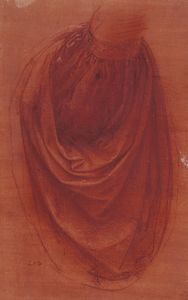

1651-1763: A Salvator Mundi of the Royal Collection which is ascribed to Leonardo da Vinci can be followed from the Royal collection to a 1763 sale (more details here).
Early 19th century: three Salvator Mundi versions in English collections, all of them linked with Leonardo, are known (and none of these are discussed by Heydenreich in 1964); moreoever: another version is in possession of the Earl of Yarborough (picture below: fondazionezeri.unibo.it; note here, as in chosen other versions, the also crucial Ω-shape (›omega shape‹; picture below: via.lib.harvard.edu) in the drapery, and compare with the one windsor sheet above on the right; present location of the picture is unknown).

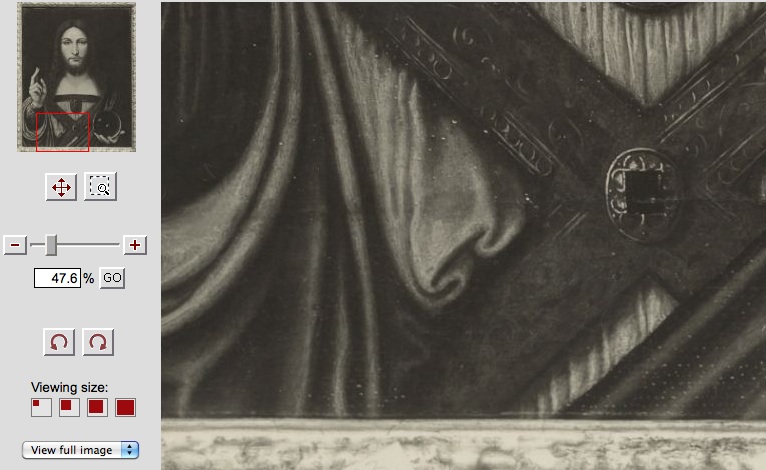
1869: John Ruskin, The Queen of the Air [with epoch-making praisal of Bernardino Luini].
1889: a Salvator Mundi (still ascribed to Giampietrino) is given to the Detroit Institute of Art (picture: dia.org):

1891: two Salvator Mundi versions, both from the collection of Giovanni Morelli and one of them depicting a young Christ, come to the Accademia Carrara of Bergamo (pictures: lombardiabeniculturali.it ; lacarrara.it):

1898: ›Masters of the Milanese and allied schools of Lombardy‹-exhibition at the Burlington Fine Arts Club (with catalogue)
1904: as a work by Quentin Matsys the later Zurich Salvator Mundi (see below) turns up at a sale at Cologne (Vente Bourgeois Frères at Heberle-Lempertz)
1907: Bernard Berenson, North Italian Painters of the Renaissance [with epoch-making dismissal of the Leonardeschi].
1915: Francesco Malaguzzi Valeri (La corte di Lodovico il Moro, vol. 2 (Bramante e Leonardo da Vinci), p. 558) points to a still all too little known 18th century source: Padre Vincenzo Monti, librarian of Santa Maria delle Grazie of Milan, speaks of a lunette painting done by Leonardo above a door in Santa Maria delle Grazie, a painting depicting the Saviour, and a painting which, according to this source, had been destroyed in 1603, due to an enlarging of this door. It may be that Salvator Mundi studies in general have neglected this source, blinded by the existence of the Hollar etching. Since it may also be that, if this lunette in fact did exist (and perhaps also a cartoon), all other derivatives might have been done by Leonardo pupils, which means that the whole Leonardesque Salvator Mundi family, including the model for the Hollar etching, might stem from this lost lunette. Italian scholars (P. C. Marani; C. Pedretti) have occasionally mentioned Monti’s testimony, his Catalogus, but Santa Maria delle Grazie has not especially been in focus of Salvator Mundi studies, all the more, of course, since the existence of minor works by Leonardo might have been outshadowed by the Last Supper.
(For an updated discussion of the above topic see now here.)
1929: Wilhelm Suida, Leonardo und sein Kreis (see also for the Italian subgroup of Salvator Mundi versions).
1964: ![]() Ludwig H. Heydenreich (picture: faz.de), Leonardo’s »Salvator Mundi« (Raccolta Vinciana, Fasc. XX; without mentioning, by the way, of the Monti testimony).
Ludwig H. Heydenreich (picture: faz.de), Leonardo’s »Salvator Mundi« (Raccolta Vinciana, Fasc. XX; without mentioning, by the way, of the Monti testimony).
recalls also a Warsaw version: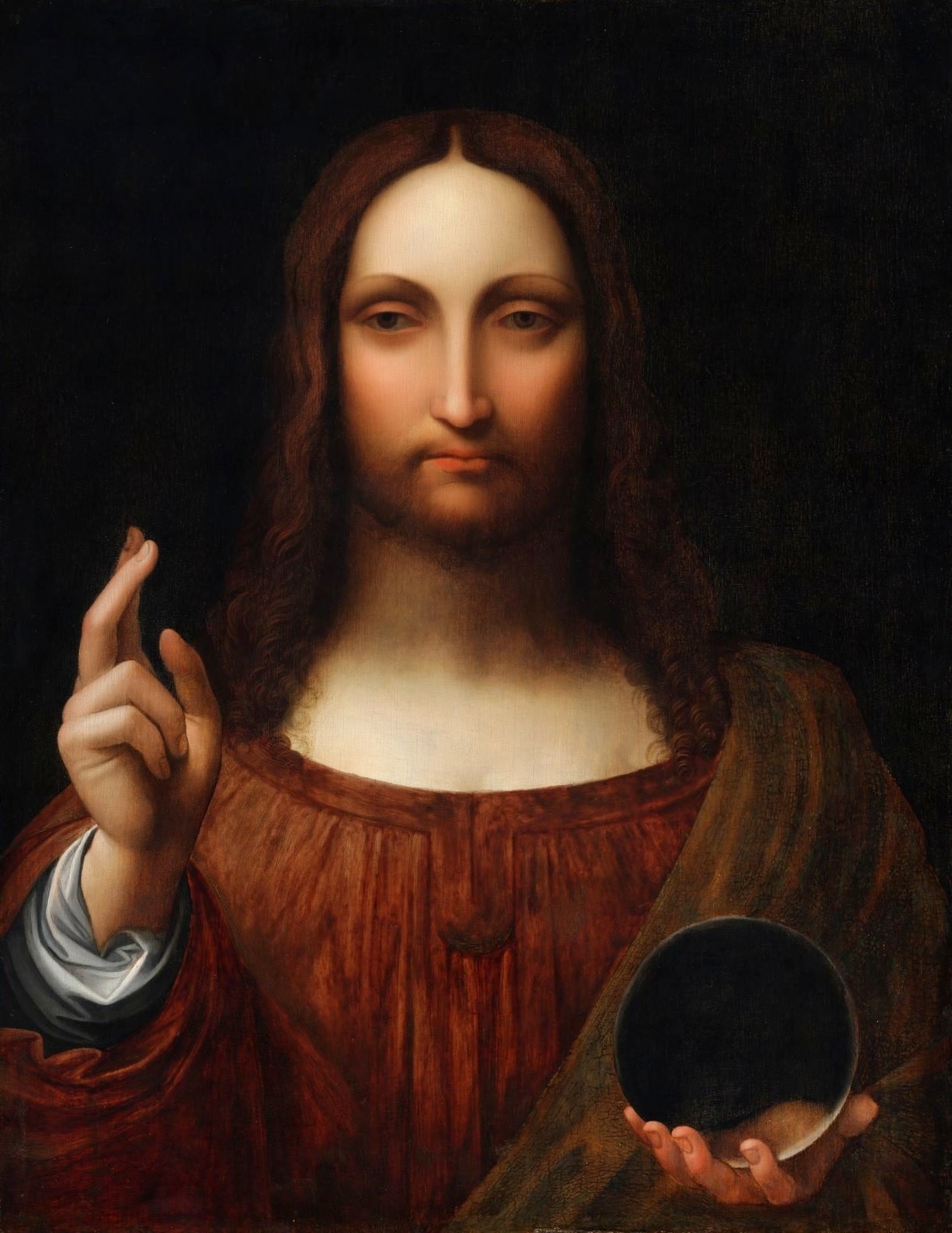

and also a Zurich version (then: Stark collection; present location unknown; picture: DS, after Raccolta Vinciana):

1982: Joanne Snow-Smith, The Salvator Mundi of Leonardo da Vinci. And we may speak of a end of 1970s and 1980s hypothesis that this is the painting the Hollar etching was made after (Salvator Mundi ex De Ganay; dismissed, by the way, by Berenson as the work of an inferior pupil of Leonardo; addition as of November 2017: Italian media have more than once assumed that Carlo Pedretti has been supporting the attribution of this version to Leonardo; Christie’s, in 2017, lays weight on the claim that Pedretti, as they believe, never asserted this; in 2011 Pedretti referred to the de Ganay picture as ›probably [by] Giampietrino‹ and dismissed the 21st century hypothesis (see further below), based on mere judgment by eye: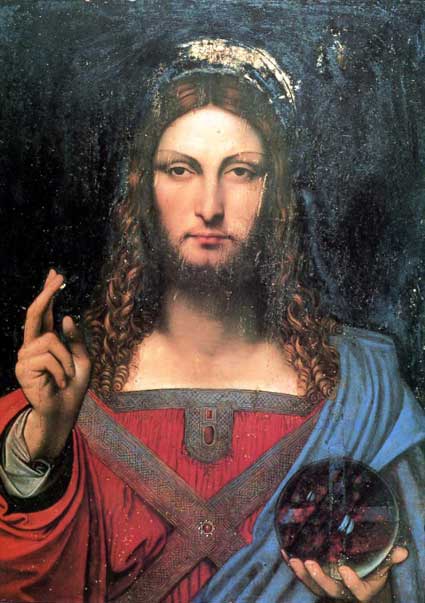

21st century: the Abu Dhabi Salvator Mundi is becoming notoriously famous.


And here again the version ex-Versailles that would, I believe, deserve somewhat more attention (picture: fondazionezeri.unibo.it)
(According to A. Vezzosi on canvas and in a private collection; angels added in 1843; in 1844 this work was donated to the Versailles Cathedral by archevêque Louis Blanquart de Bailleul)
2018: Baltic Oaks (exhibition of 16th and 17th century Dutch and Flemish pictures in the Latvian National Museum of Art at Riga; picture below: lnmm.lv).


See also:
Some Salvator Mundi Microstories
Some Salvator Mundi Afterthoughts
Some Salvator Mundi Variations
How To Tell Leonardo From Luini
MICROSTORY OF ART
ONLINE JOURNAL FOR ART, CONNOISSEURSHIP AND CULTURAL JOURNALISM
HOME
© DS